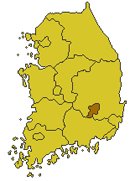Japan: the Far, Far East
The sun was distant as we herded onto the swaying boat, bedecked with the typical Korean blare of colors and patterns, and the lingering smell of stomach acid. On the TV in front of the seats, a muted infomercial for a Hello, Kitty! vibrating belly buster flashed. We chugged out through a maze of rust-streaked cruise and cargo ships, and into a smooth expanse of the gray sea. The Sea of Japan, according to my seventh-grade geography teacher and most of Western history. It's only this year that I realized there were other accounts, that every Korean, down to the third grade, will cry out indignantly if you happen to call it other than the "East Sea." The decades of Japanese rule still don't sit well with Koreans, and this name debate is only part of the ongoing tension. Even the venerable National Geographic - the closest thing to a world authority on place names - hasn't ruled decisively on the matter, using both (though Japan's more prominently).
It's not the only thing separating these two Pacific Rim countries.
When the boat docked at Fukuoka, I was greeted by my friends and a world of order and sophistication. Spic and span streets are lined with methodical architecture and dazzling LCD screens. Trendy couples shield runway-worthy getups from the drizzle with clear plastic umbrellas, which they then lock in special cases at the entrances of gourmet restaurants. Potted flowers adorn temporary construction walls. There are whole parking garages for bicycles, which Japanese can maneuver while holding umbrellas AND texting on their cellphones. Crosswalks play music. Robots roll through malls, delivering advertising and information. Toilets have heated seats and an inspiring array of buttons and levers. And a plethora of English and well-thought signage makes it easy for foreigners to navigate most any system. Everywhere, things are tidy, planned and systematic.
Korea is a country in the midst of a near-miraculous rebound from millenniums of invasions and a quite recent civil war. But even the relatively cosmopolitan and enormous Seoul is nowhere close to the dazzle of much smaller cities here in Japan, or so I've seen and heard. Apparently, the rush of cash here after World War II created an economic force powerful enough to lift the country from devastation to prosperity in just a couple decades. Although its economic landscape has changed dramatically in recent years, and other nations are now making inroads on its markets, this small set of islands continues to be a world powerhouse. Japan provides a stable and modern lifestyle for its population - albeit at a high cost of living and grueling work demand.
The ferry from Busan, South Korea, takes about three hours, and Fukuoka is a common hangout for those needing to start the clock over on Korean tourist visas or change Korean visas. It's on the island of Kyushu, which also includes Nagasaki, site of the second atomic bomb. We spent one day touring there. "Hi, my grandfathers bombed your grandfathers, and now I'm here to take a picture." It was a little weird. But definitely worth going - the museum, park and memorial are both moving and educational. And although the bombing of Pearl Harbor is conspicuously left out of timelines of events leading up to Nagasaki disaster, it's awe-inspiring how otherwise politically neutral and peace-focused the displays are.
Otherwise wandered around Fukuoka sites, took a three-hour tour of the suburbs when we took the wrong bus (I was NOT in charge, surprisingly), ate lots of raw fish (yum!), discovered a hot lemon drink (yum!), checked out the rave-reviewed La Boheme Italian restaurant (a must-go if you're in the city), and crashed at the Khaosan Fukuoka International Hostel - a good place to stay if you don't mind a walk, or paying an extra bus fare.
Here's a slideshow of pictures. You can click on it to get to the full album with captions.


1 comment:
Nice photos and news to me about the "East Sea". Thanks...Dad.
Post a Comment